This swift exchange between the schoolteacher-turned-rebel Udayan Pandit and the protagonists Goopy and Bagha in the film Hirak Rajar Deshe (Kingdom of Diamonds, 1980) sums up the universal humanism that permeated Satyajit Ray’s films. Simple yet profound.
This “children’s film for everyone” is a landmark work of art dealing with resistance against tyranny, with a people’s uprising against totalitarianism. Forty years later, Hirak Rajar Deshe—the tale of a teacher and his unlikely allies, Goopy the singer and Bagha the drummer, toppling a tyrant—rings truer than ever, as leaders around the world display streaks of the anti-democratic Hirak Raja, out to suppress any form of dissent or critique.
Hirak Rajar Deshe ends on a note of idealistic hope and popular rejoicing as the despot is subjected to his own magajdholai (brainwashing) machine, his giant statue is pulled down by the people, and freedom and justice are restored to the land.
The endings of Ray’s films often symbolize the humanism and hope that he came to typify as a unique creative force between 1955 and 1992.
Take Ganashatru, his 1989 film based on Henrik Ibsen’s An Enemy of the People, but transcreated in a Bengali small-town setting. Ibsen’s play ends on a brutal individualistic note— “the strongest man in the world is he who stands most alone”. Ray’s film, however, ends with the upright, idealistic doctor hounded by his community for standing up for science and truth, asking “There is hope?”, and on cue the sounds of a rally in his support organized by a young and educated group of locals can be heard. Overwhelmed, the doctor exults, “I am not alone!”

